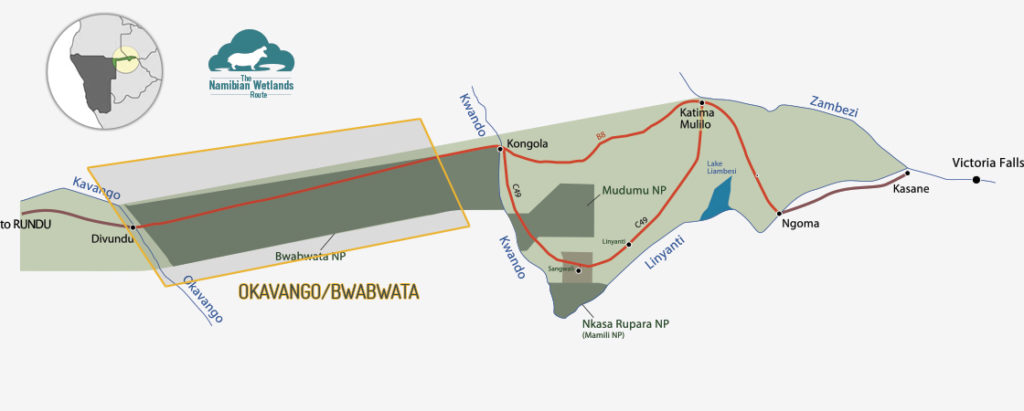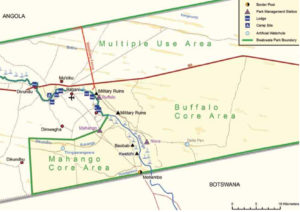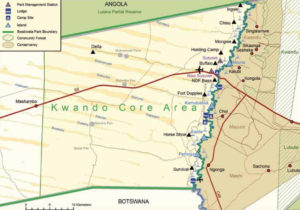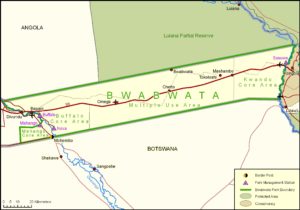OKAVANGO | BWABWATA
INTRODUCTION
The Okavango – Bwabwata area starts on the banks of the Okavango River, just East of Divundu and ends at the Kwando core area West of Kongola. This area is part of the Bwabwata National Park.
The park was first proclaimed as the Caprivi Game Reserve in 1966 and upgraded to the Caprivi Game Park in 1968. It was gazetted as the Bwabwata National Park in 2007 and incorporated the former Mahango Game Reserve. The park has had a chequered history as it was declared a military area by the South African Defence Force during Namibia’s war of liberation. It was not until after Independence in 1990 that the park could be properly run as a conservation area.
A survey was conducted in the park at Independence to investigate the status of the fauna and flora after the military occupation and to assess the circumstances of the 5 000 people living in it. This survey laid the foundation for the current management approach in the park, which incorporates the needs of the people living there. The survey also laid the foundation for the zoning of the park, which has a core conservation area in the west along the Okavango River, a multiple use area in the central part of the park and a core conservation area in the east along the Kwando River.
Development of infrastructure, provision of equipment and park planning are being supported by the German Government through KFW and implemented by Namibia Parks Programme (NAMPARKS).

BWABWATA NATIONAL PARK
Shaped by water, woodlands, floods and fire, human history and ancient animal migration routes, Bwabwata National Park is rich in biodiversity and history. Effective management of Bwabwata, together with the other North-East Parks (Khaudum, Nkasa Rupara, Mangetti and Mudumu National Park) will ensure the conservation of important habitats, safeguard corridors for regional wildlife migration; provide engines for economic growth in poor rural areas; and provide access to natural areas for local, regional and international visitors.
Covering a vast area of 6,274km2, Bwabwata National Park is the largest of the four protected areas that make up the North-East Parks. Bwabwata is comprised of three Core Areas designated for special protection and controlled tourism – Kwando (1,345km2), Buffalo (629km2), and Mahango (245km2), and a large Multiple Use Area (4,055km2) zoned for community-based tourism, consumptive tourism, human settlement and development by the resident community.
Except for Mahango, which is positioned on the western bank of the Kavango River, the Park completely covers the section of the Zambezi Strip, which extends from the Kavango to the Kwando Rivers. The boundary between the Zambezi and Kavango regions lies roughly in the middle of the strip.
The Park is bordered by Angola to the north and Botswana to the south. The northern boundary is demarcated by only a cut-line, however, the southern boundary is fenced with three veterinary standard fences, except for a 30-kilometre stretch, which lies west of the Kwando River.
At either end of the Park are small settlements – Kongola in the east and Divundu in the west. The Trans-Zambezi
Highway (B8) traverses the Park in the middle from east to west, and a minor road (C48) dissects Mahango in a north-south direction. A number of small settlements have emerged inside the Multiple Use Area, the largest of which are Mutc-iku, Omega, Chetto, Omega 3 (Tokoloshi) and Mashambo. The population of Bwabwata Multiple Use Area is approximately 5,500 residents, of which 80% are of the minority San ethnic group, the Khwe.
Natural Environment
Bwabwata straddles the largest section of Kalahari Woodland in Namibia, stretching from the Kwando River in the east to the Kavango River in the west. The biodiversity of the omiramba and associated fringe woodlands is considered to be moderately sensitive and scarce, while the riparian woodlands and floodplains are highly sensitive and scarce. Broadleaved woodlands are considered to be less sensitive and scarce.
An outstanding feature of Bwabwata is the high number of large mammal and bird species that are nationally rare. The omiramba and their associated grasslands are habitat for roan, sable and tsessebe. Typical trees include Baikea plurijuga (Zambezi Teak), Pterocarpus angolensis (Teak), Burkea africana, Mangetti and several others, including several Strychnos (Monkey Orange) species. Plant species composition varies greatly between grassland, broadleaf woodland on deep sands, mixed woodland on the more loamy soils of the alluvial floodplains of the Kavango River, and riparian woodland.
The primary driver of ecological patterns in Bwabwata National Park is soil types. Infertile deep sands are contained in paleo dunes interspersed with more fertile clays in broad inderdunal valleys (omiramba). In general, the dunes carry broadleaved large trees (such as Zambezi Teak), while Acacia species and Leadwood dominate the interdunal omurambas where clay soils tend to dominate. The Mahango Core Area contains a large discrete area of highly erodible soils (possibly sodic) that support a distinct plant community.
Apart from the strong influence of soil types, dominance, and hence structure of vegetation, is often determined by the relative frequency and intensity of fires experienced over the last decade or more, as well as by impacts associated with elephant. Humans, both resident in Bwabwata and transient, are probably the cause of most of the fires.
Elephant populations have increased over the past few years to a decade, with high densities often occurring in the Buffalo Core Area and along the Kwando woodlands, where they regularly move between Namibia, Angola, Botswana and Zambia. Disturbances by fire and elephant are both part of the natural ecological dynamics of these woodlands. As long as water is seasonally available in the veld away from the rivers, and providing elephant are allowed to freely move between countries and not encouraged to stay in the area by provision of artificial water, they are unlikely to have irreversible impacts on the vegetation (at least at their current population levels).
Seasonal movements by several game species to and from both rivers are prominent in the omuramba systems of Bwabwata. These game species, which include elephant, buffalo, zebra, wildebeest and (to a lesser extent) roan, tend to cluster at the rivers during the dry season and move inland during the wet season. This natural seasonal cycle is an important mechanism that maintains vegetation structure, as most vegetation experiences a resting period during some part of the year.

